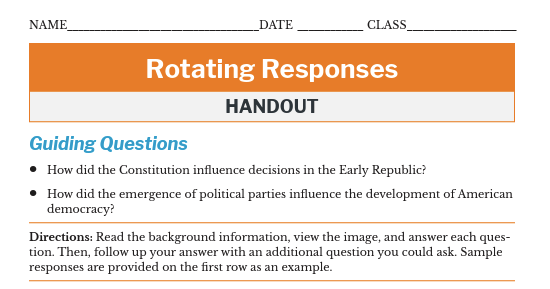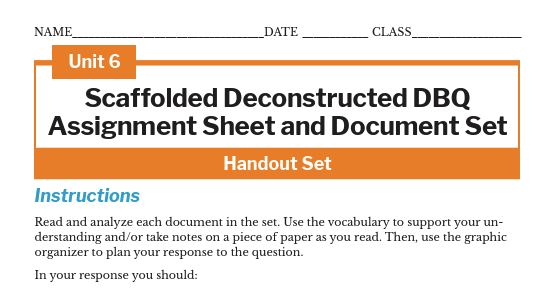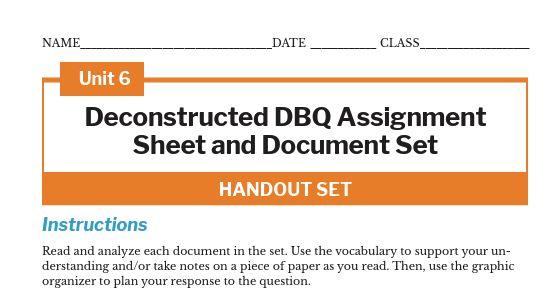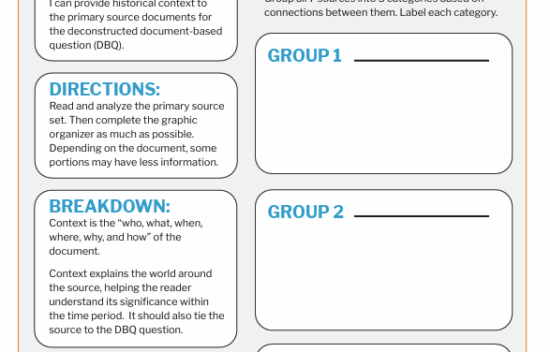
Unit 6: America in Transition Deconstructed DBQ
Lesson Components
Guiding Question
- How did Americans and democratic institutions respond to the rapid economic changes of the early nineteenth century?
Objectives
- Students will provide historical context for primary source documents.
- Students will engage in critical thinking to interpret historical perspectives using VIEW (Voice, Intent, Environment, Who).
- Students will develop a thesis statement using historical evidence.
- Students will group sources based on similarities and historical themes.
- Students will develop a thesis that answers the guiding question using evidence from grouped sources.
Materials
Student Materials
- Rotating Responses Handout
- Unit 6 Context, Thesis, Grouping, VIEWing Documents Deconstructed DBQ Graphic Organizer
- Document Set (choose 1):
- Unit 6 Deconstructed DBQ Assignment Sheet and Document Set
- Scaffolded Deconstructed DBQ Assignment Sheet and Document Set
- Documents contained within both sets include:
- Document A: Excerpt from a young woman working in the Lowell Mills (1830s or 1840s)
- Document B: Excerpt from Angelina Grimké’s “Letter to Catharine Beecher” (1837)
- Document C: Excerpts from “Letters from an Immigrant” by Johan Schütz (1840s)
- Document D: Excerpt from the Seneca Falls Declaration of Sentiments (1848)
- Document E: The County Election by George Caleb Bingham (1852)
- Document F: Excerpt from Frederick Douglass’ What to the Slave is the Fourth of July? Speech (1852)
- Document G: Excerpt from Henry David Thoreau’s Walden (1854)
- Documents contained within both sets include:
Teacher Materials
- Unit 6 Deconstructed DBQ Document Set and Teacher Context Teacher Resource
- Unit 6 Model Organizer and Scoring Guide Teacher Resource
- Unit 6 Slide Deck
Teacher note: There are two versions of the deconstructed DBQ documents. The original version includes light scaffolding and is intended for assessment. The second version is more scaffolded and is intended for using the deconstructed DBQ as a learning activity. The two versions can also be used for different levels of learners in the same class.
Facilitation Notes
- This mini-lesson reinforces the skill of providing context, which was introduced in Unit 5.
- This mini-lesson is intended to take 45-60 minutes and focus on a specific skill. It was created to accompany the mini-lesson teacher slide deck.
- This lesson was created to build upon the previous Deconstructed DBQ lessons. However, it can be implemented in isolation with additional supports. Modify the lesson by using the scaffolding notes to fit your classroom.
Anticipate (Optional)
Deconstructed DBQ skill Video Intro
- Assign, or watch as a whole group, the supplementary Deconstructed DBQ skill video for the unit.
- The video will introduce a new primary source from the time period, give historical context and analysis, and then lead students through using the source to answer the Deconstructed DBQ question with a thesis statement.
- Pause the video at the processing questions embedded in the video to prompt reflection and discussion.
Teacher Note: The Deconstructed DBQ videos work as a pre-teaching tool, but can also be used as a scaffolding support later in the mini-lesson. The video is based on a source not included in the Deconstructed DBQ document set, so that this video can be used as a resource in classrooms using the DBQ for skills building, assessment, or both.
Engage
Rotating Responses
- Transition: Distribute the Rotating Responses Handout.
- Instruct students to work independently on the handout to prepare for the activity.
- Students will read the background information and carefully view the image.
- Then, they will answer the questions and craft a follow-up question for each.
Scaffolding note: Providing a time limit for this stretch of independent work time can help keep the pace of the class. The handout could also be assigned for homework the day before.
- When time has elapsed, or students have completed the handout, assign a number from 1 to 4 for each student. This will create groups of 4, with each student having an assigned number.
- Then use one group, or volunteers, to conduct a practice round demonstration before allowing groups to discuss independently.
Scaffolding note: This is a repeated activity from the Unit 5 deconstructed DBQ, intended to give students more autonomy in the activity. If this is your first time using the Rotating Responses activity, you may want to do the whole activity as a demonstration with one group conducting the activity. Flex the method to fit your students.
- Each student in the group is assigned a role in the discussion.
- Student 1: Reading the question
- Student 2: Answering the question
- Student 3: Providing praise and encouragement
- Student 4: Asking a follow-up question
- All students then discuss the follow-up question informally
- Students use their roles to answer the first question, then rotate for the second question, continuing until they answer all four questions and have had all four roles.
- Use the slide deck to support this activity, it contains a slide the guides students through each round of the activity.
Introduce the Deconstructed DBQ
- Tell students: “Today we will investigate how the Constitution influenced decisions in the Early Republic by working with primary source excerpts.”
- Distribute the deconstructed DBQ document set and allow students 3-5 minutes to skim them and ask any questions they may have.
Scaffolding note: There are 7 documents in this primary source set. Scale the set to fit the needs of your students if needed. 3-4 documents is a good place to start.
Teacher note: There are slides in the teacher deck to facilitate a whole-group discussion or reading if your students need more support.
Explore
Grouping Sources
- Transition: Distribute the Unit 6 Graphic Organizer.
- Students group documents based on shared themes, common attributes, constitutional principles (e.g., separation of powers, individual rights), or any other categories they decide.
- Encourage students to justify their groupings in writing using evidence from the documents.
- Sample groupings:
- Group 1: Hope, Opportunity, and Democratic Expansion
- Document C (Immigrant letter)
- Document E (The County Election)
- Document G (Walden)
- These sources reflect optimism, opportunity, and the broadening of American identity and participation.
- Group 2: Protest, Reform, and Unmet Promises of Democracy
- Document A (Mill worker)
- Document B (Grimké)
- Document D (Seneca Falls)
- Document F (Douglass)
- Group 1: Hope, Opportunity, and Democratic Expansion



